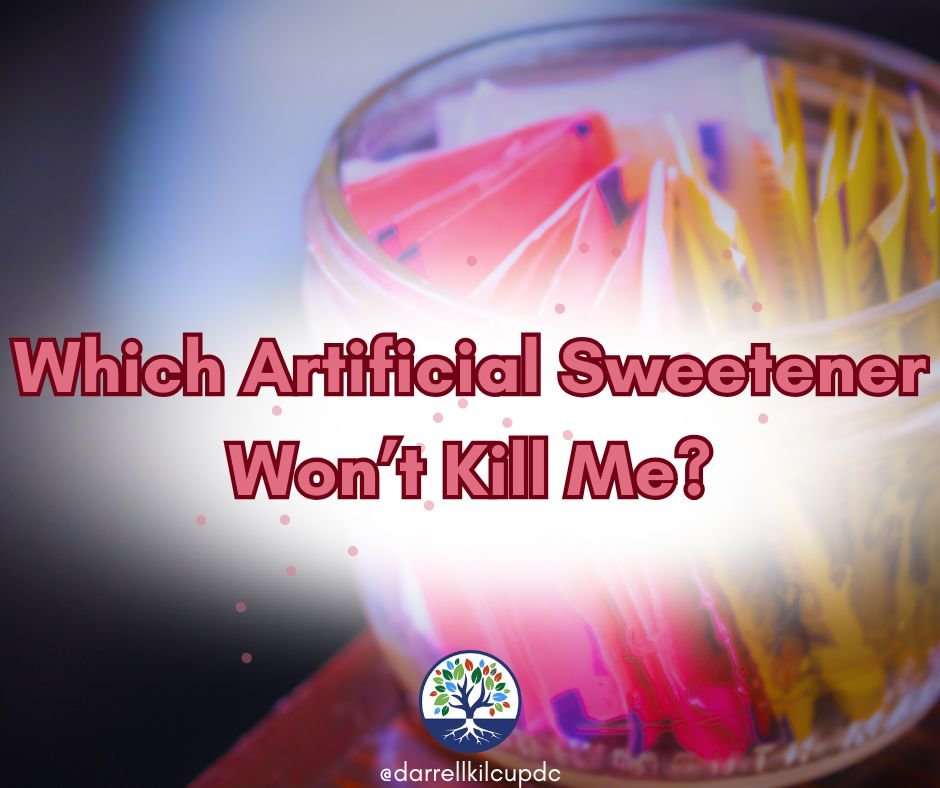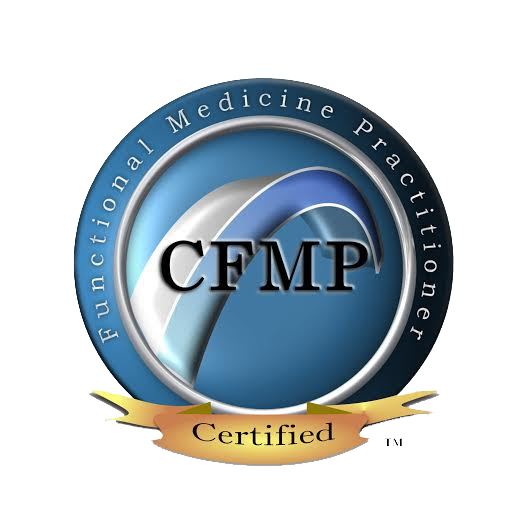
An artificial sweetener can be a great way to cut back on calories, and still satisfy that sweet tooth. Are you concerned about the negative health effects of refined sugar, but don’t want to give up your desserts?
Are you wondering if there is an artificial sweetener that isn’t cancer causing toxic waste? Lately, I’ve been asked a lot about natural and artificial sweeteners. Because serving brings me joy, I decided to write about natural and artificial sweetener products so my patients could become educated and make informed choices.
There are plenty of reasons to cut out refined sugar. Did you know that cancer feeds on sugar? Sugar not only rots your teeth, but also spikes insulin levels which can lead to Type 2 Diabetes. High fructose corn syrup is no better, in fact in some ways it’s worse. It can cause leaky gut and lead to inflammation anywhere in the body. HFCS is cheaper and also sweeter than sugar, which is why food manufacturers use it in so many products from soda to candy to foods you might not even think had a sweetener. There are also sugar cousins with other names including anything ending in “-ose,” fruit juice concentrate, and corn syrup. Check your labels. There are more natural and organic sugars, like turbinado, rapadura (Sucanat) evaporated cane juice and organic raw sugar. They are all sucrose and devoid of nutrients.
Alternatives to sugar and HFCS could be classified as artificial sweetener, sugar alcohols and natural sweeteners.
You are probably familiar with the popular artificial sweetener products, but there are others that you many not recognize on a food label. The artificial sweeteners include Acesulfame K (AceK or ACE), Alitame, Aspartame (Aspartyl phenylalanine methyl ester or APM), Aspartame-acesulfame Salt, Saccharin, Neohesperidin DC (NHDC), Neotame and Sucralose. (NHDC is a food additive used for flavor enhancing and hiding bitterness. It’s used in condiments, sweetened dairy products, alcoholic beverages, toothpastes and pill coatings.)
The best advice I can give about an artificial sweetener products is to stay away from them. It is much healthier to avoid putting anything in your body that is artificial. Keeping your food as close to the way it came out of the ground is the best. There are all kinds of negative health effects linked to artificial sweetener products, from migraines to leaky gut, sleep disorders to joint pain, and some really serious ones like vision problems, seizures, type 2 diabetes and even cancer.
They don’t even help accomplish what most people use them for, which is weight loss and insulin management. When you taste something sweet, your brain tells your body to prepare for incoming energy, but since there is none (no calories) in a artificial sweetener, you will feel hungry for more, even up to two hours, causing you to eat more. The insulin response they trigger tells your body to store fat, especially belly fat.
Most sugar alcohol artificial sweetener products can be recognized by the “-ol” ending.
Sorbitol, manitol, malitol, hydrogenated starch hydrosolate or HSH, and erythritol are derived from cornstarch. Xylitol can be made from corn cobs, sugar cane stalk residue or birch wood waste. Xylitol has the benefit of helping prevent tooth decay. Isomaltitol or isomalt comes from sugar, and lactitol comes from the lactose in milk. They are all very low calorie sweeteners, but they are all less sweet than sugar. On the downside, they can cause stomach upset, diarrhea and gas. This is a red flag for me, as gut health is really important. Erythritol is an exception to this, and seems to be well-tolerated by many people.
Natural sweeteners can have benefits, but most are also not low calorie. Here’s the scoop:
Agave Nectar
Agave nectar may be a very healthy sounding sweetener, but it is bad news. The problem with agave is that it contains an extremely high level of fructose, even higher than HFCS. What’s so bad about fructose, you say, isn’t that what makes fruit taste sweet? Fruit does contain small amounts of naturally-occurring fructose, but also contains other nutrients—enzymes, vitamins, minerals and fiber. Your body doesn’t deal with isolated fructose, like that contained in agave, as it does with fruit. Fruit is digested in the intestines, while isolated fructose is digested in the liver where it is converted to triglycerides or stored as fat. This can lead to insulin resistance and fatty liver disease.
Agave is not a good natural choice for a sweetener.
Black Strap Molasses
Black strap molasses is a byproduct of extracting the sucrose from the sugar cane plant. Unlike sugar, it contains good amounts of several beneficial vitamins and minerals, including B vitamins, manganese, magnesium, iron, potassium and selenium. Menstrual cramping and constipation can be relieved with molasses consumption. Bone, hair and skin health can benefit too. It does have a few more calories than sugar, at 19 calories a teaspoon compared to sugar’s 16, so it is not a low calorie substitute, and it does contain fructose, about 11-20%, plus the sucrose content of about 38%.
Raw Honey
Raw honey contains vitamins, minerals, and antioxidants, and has antifungal and antibacterial properties. The vitamins and minerals it contains depends on the source of nectar the bees use to make it. Honey that is not raw, even organic honey, will not have the nutritional benefits of raw honey, because of the heat used in processing. Some honey on the store shelves isn’t even pure honey, but has HFCS or other sweeteners added to it. Raw honey definitely has benefits, but it is not a low calorie sweetener with 21 calories per teaspoon. It also contains about 41-50% fructose. Honey can contain bacterial spores that are dangerous for babies under the age of one.
Maple Syrup
Maple syrup is made by collecting sap from maple trees, boiling out most of the water and then filtering out impurities. The grades of syrup are based on color and flavor, not quality. Pure maple syrup (not maple flavored syrup) contains vitamins, minerals (calcium, thiamine and zinc) and antioxidants, and could have anti-cancer and anti-bacterial properties. However, it is high in sucrose (sugar) at about 58-67% with a very small amount of fructose, 0.5% and it’s calorie content is about the same as sugar.
Date Sugar
Date sugar is produced by drying and crushing dates. The minimal processing preserves most of the nutritional value of the dates. A study recently done in Israel showed some health benefits of dates including anti-oxidant properties as well as reducing risk of stroke, heart and vascular disease. It is high in sucrose and it’s fructose content is about 25%. There are 15 calories per teaspoon, and it can be used in the same proportion as sugar in recipes, but it does not dissolve in water.
Coconut Sugar
Coconut nectar or sugar comes from the sap of the coconut palm. It contains some nutrient value, including vitamins, minerals and amino acids, however you would have to consume quite a bit in order to benefit much from those. It’s glycemic index is lower than sugar, but the caloric content is the same. It is less processed than refined sugar, making it better choice than sugar, but not if you’re trying to cut calories.
Monk Fruit
Monk fruit, also known as Lo Han Guo, or Lo Han Kuo. Lo Han Guo is a fruit grown and used as food and herbal medicine in China. The fruit itself has some bitter and astringent flavors in addition to sweetness, so it must be processed by extracting the sweet components and removing the unpleasant flavors with chemical solvents. In addition, most brands of monk fruit sweeteners have added ingredients including bulking agents, chemical preservatives and other sweeteners, even sugar!
One brand, Lakanto, includes only one other ingredient, erythritol, one of the safer sugar alcohols. That may be your best option if you choose a monk fruit sweetener. Lakanto is a zero calorie sweetener.
Stevia
Stevia has to be my favorite sweetener. It is derived from the leaves of the stevia plant of South America. It is also cultivated in Africa and Asian countries, including China, the leading exporter of stevia. With zero calories, zero carbs and sweetness 250-300 times that of sugar, it is a winner! It contains Vitamin B3, potassium, zinc, and magnesium, and fiber. Studies have shown that stevia has little to no effect on blood sugar levels or insulin response. One of stevia’s antioxidant compounds has been shown to reduce the risk of pancreatic cancer. Stevia also has anti-bacterial and anti-fungal properties. It is safe for people of all ages.
Truvia is not a good choice, as it is highly processed and removes only the sweetest component of stevia instead of the whole plant extract. Be sure to look for pure organic stevia!
Here’s the Deal:
If you think you can lose weight by continuing to consume lots of junk food or soft drinks but just switching to a low or no-calorie sweetener, you will not be achieving better health, or even long term weight loss. In some cases you will end up with worse problems than being overweight. In other cases you will still be fat and get diabetes. I just read a study today that linked diet soda to type 2 diabetes.
If you want to replace sugar with a natural sweetener of similar caloric content, you may benefit from the nutrients it contains, but if you overdo it the damage will outweigh any benefit. We often hear, “Anything is fine in moderation.” So what is moderation when it comes to sweets? Well, that’s hard to say, but it’s probably not moderation if you eat sweets every day. The more you can cut sweets of any kind out of your diet, the more you will benefit. Replacing a sugary treat with a piece of fruit is much better than replacing the sweetener in the treat. And replacing soda with water or tea is a huge step in the right direction!
I don’t believe in telling my patients what to do. I believe people are going to do what they believe will make them happy. Instead, I educate my patients so that they have the information they need to make the best choices. Now go make good choices!
Click here for references
drhyman.com/blog/2011/05/13/5-reasons-high-fructose-corn-syrup-will-kill-you
glycemic.com/DietSodas.htm
nature.com/nature/journal/vaop/ncurrent/full/nature13793.html http://www.processedfreeamerica.org/resources/health-news/593-agave-nectar-healthy-or-not/
sugar.org/other-sweeteners/sugar-alcohols/
organicfacts.net/health-benefits/other/health-benefits-of-molasses.html/
sugar-and-sweetener-guide.com/blackstrap-molasses.html/
organicfacts.net/health-benefits/health-benefits-of-honey.html/
sugar-and-sweetener-guide.com/honey.html
naturalnews.com/030110_coconut_nectar_vinegar.html https://hort.purdue.edu/newcrop/articles/momordica%20croom.html
itmonline.org/arts/luohanguo.htm
southernsavers.com/organic-living-journey-alternative-sweeteners-monk-fruit/
medicalnewstoday.com/articles/287251.php
epicurious.com/ingredients/grade-b-maple-syrup-buying-guide-article sciencedaily.com/releases/2010/03/100321182924.htm
sugar-and-sweetener-guide.com/maple-syrup.html




